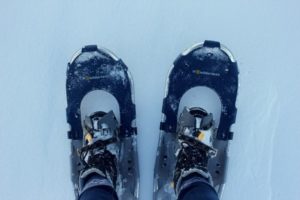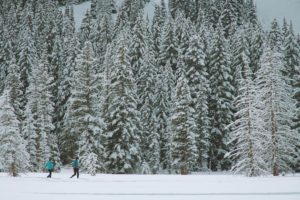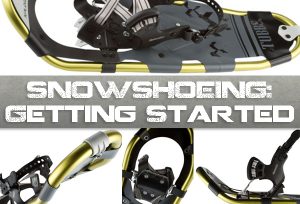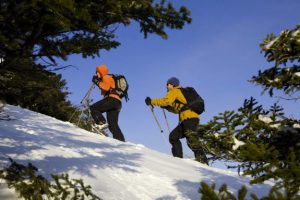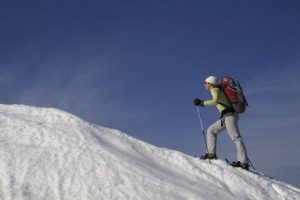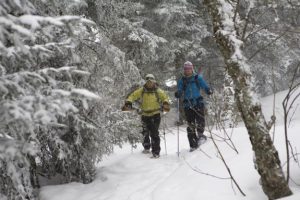
The sport of snowshoeing has gained immense popularity over the years as a cost effective, caloric burning and enjoyable means of exploring the wintry outdoors. It’s sort of like having big bear feet that can plow through any amount of snow or terrain. There is basically zero learning curve – if you can walk, you can snowshoe! Crazy as it sounds, snowshoes date back to the days of animal trapping, fur trading and life before sliced bread. Today, families, back country mad men, cardio junkies and even toddlers effortlessly tromp through the snow while increasing stamina, improving endurance and getting a healthy dose of nature.
If you’re ready to step onto a new pair of snowshoes this winter, The House has a wide selection and the best prices on Tubbs Snowshoes. A household name since 1906, Tubbs uses quality materials that deliver season after season. They’ve even perfected women’s snowshoes, giving them a narrower frame and unique binding design. Since women have a very different frame and a smaller stride than men, it’s important to outfit yourself or your lady in gender specific snowshoes for the most enjoyable experience.
Where to Snowshoe?
You won’t need to wait in line, drive to the mountain or buy a lift ticket to snowshoe. Golf courses, state or local parks, and even your own back-yard can be a snowshoe haven. Snowshoe specific trails also exist at Nordic Centers near ski resorts, bed and breakfasts or inns and national parks. Skiiers and snowboarders in search of pristine powder, earn their turns in the backcountry and side country by trekking out of bounds. Snowshoes make it possible to ascend beyond the lift or to venture outside of marked trails.
How to Snowshoe

A natural and normal stride is best, although the feet must be slightly wider than normal to avoid hitting the insides of the snowshoes. The inner thighs will love this low impact workout! Most people simply walk in their snowshoes, but others run in snowshoes on designated trails and even partake in organized races.
Packed snow is ideal for beginners, while cleats and a kicked up nose enable the user to walk up hills and plow through deeper snow. When walking down a slope, smaller steps should be taken with the knees slightly bent for increased stability. Snowshoeing uphill tends to come more naturally and has the added bonus of toning your buns! For longer treks with diverse terrain, snowshoe poles are quite helpful for balance and giving the upper body an added workout.
Snowshoe Sizing
While snowshoes are sized by length, weight is the most important factor when determining snowshoe size. No fudging your weight either! The more you weight, the wider the footprint of the snowshoe and the longer the length. This will enable you to sink perfectly into powder – not too much and not too little! The House provides size charts for every model that will help you determine the proper length of your snowshoes.
Types of Snowshoes
Depending on your snowshoe intentions, there are three styles of snowshoes. Although they are all fairly versatile, the most expensive pair doesn’t necessarily mean that they’re “the best” for all types of users. What’s nice about snowshoes is that upgrading in the future won’t be a major investment like dropping in on a carbon fiber bike frame.
- Recreational snowshoes are ideal for users who live close to trails, parks or open space where one can easily get their snowshoe on. The majority of users fall under this category. These value oriented models offer easy to use bindings and are designed for flat or rolling terrain with primarily packed snow. Running specific snowshoes also fall under this category.
- Adventure snowshoes are a step above recreational models. Stronger traction, more advanced bindings and ergonomical design make treks through powder and moderate terrain effortless. Adventure snowshoes are better for ‘breaking the trail.’
- Backcountry snowshoes are hardcore to say the least. They are most suited for steep, uneven terrain with deep powder and icy slopes. Backcountry skiiers, snowboarders and backpackers typically opt for these models due to their durability, aggressive crampons, advanced binding system and dependability on untracked terrain.
Outfit Your Feet For Snowshoeing
Leather hiking boots that have been treated with a protective waterproofing spray are perfect for recreational snowshoeing. Trail running shoes are ideal for aerobic and fitness snowshoeing. And for the adventurous souls who ascend the backcountry wilderness on snowshoes in search of fresh lines, snowboard boots work perfect.
Regardless of what type of snowshoeing you plan to partake in, moisture wicking socks are crucial for the most enjoyable experience! They keep your feet warm, allow them to breath and soak up any excess moisture so your feet don’t turn to popsicles. For your ankles and calves, gaiters keep the snow out of your boots. They aren’t crucial for leisurely strolls on packed snow, but for any trail cutting or powder, gaiters will truly make or break your day! For a full snowshoe gear checklist go here.
Dress for Success!

Layering is by far the best way to dress for any winter aerobic activity. Multiple layers make it easier to control the temperature around your body. Add a layer if you’re chilly and ditch a layer before you start to sweat too much. Base layer tops and bottoms are worn directly against the skin serving as the key ingredient for moisture management and breathability. Cotton is a poor choice for a base layer since it will soak up sweat the instant the body starts to perspire. Once that happens and you stop moving, get ready to shiver in your own freezing sweat!
An insulating layer such as a fleece is ideal for the second layer. Fleece offers a bump in the warmth department without compromising range of movement or adding excess bulk. If it’s 30 degrees or above, two layers should be sufficient. Pack a technical shell in your pack in case the temperature drops or if it starts to dump snow. This outer layer is your main defense against blustery winds and precipitation.
Don’t forget a hat and a pair of gloves or mittens! If you start to overheat, take off your hat for a bit to quickly dump some heat. If you tend to sweat during aerobic activities, lighter gloves or mitts will best protect your hands from getting clammy.
Last but not least, have fun out there!!



